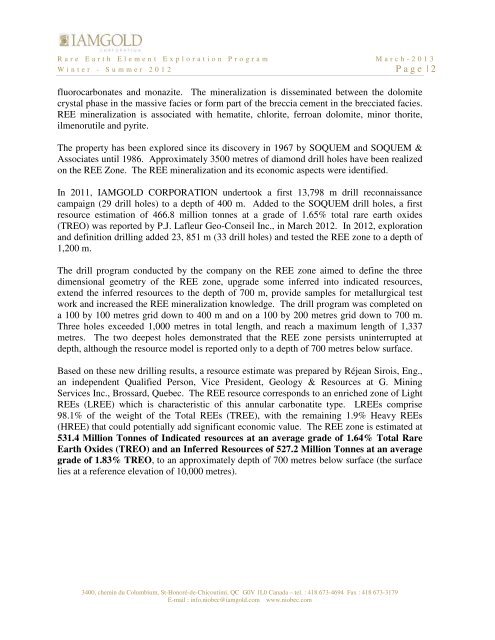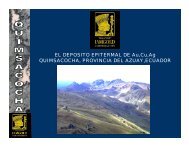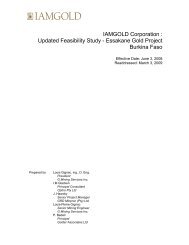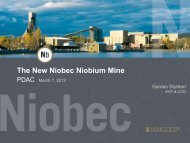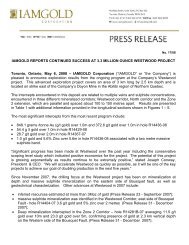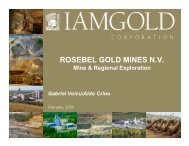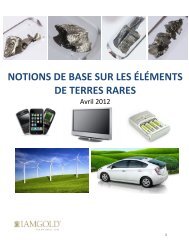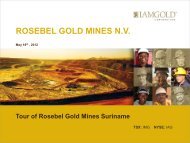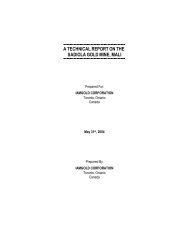NI 43-101 Technical report, Surface diamond drilling ... - Iamgold
NI 43-101 Technical report, Surface diamond drilling ... - Iamgold
NI 43-101 Technical report, Surface diamond drilling ... - Iamgold
Create successful ePaper yourself
Turn your PDF publications into a flip-book with our unique Google optimized e-Paper software.
R a r e E a r t h E l e m e n t E x p l o r a t i o n P r o g r a m M a r c h - 2 0 1 3<br />
W i n t e r - S u m m e r 2 0 1 2 P a g e | 2<br />
fluorocarbonates and monazite. The mineralization is disseminated between the dolomite<br />
crystal phase in the massive facies or form part of the breccia cement in the brecciated facies.<br />
REE mineralization is associated with hematite, chlorite, ferroan dolomite, minor thorite,<br />
ilmenorutile and pyrite.<br />
The property has been explored since its discovery in 1967 by SOQUEM and SOQUEM &<br />
Associates until 1986. Approximately 3500 metres of <strong>diamond</strong> drill holes have been realized<br />
on the REE Zone. The REE mineralization and its economic aspects were identified.<br />
In 2011, IAMGOLD CORPORATION undertook a first 13,798 m drill reconnaissance<br />
campaign (29 drill holes) to a depth of 400 m. Added to the SOQUEM drill holes, a first<br />
resource estimation of 466.8 million tonnes at a grade of 1.65% total rare earth oxides<br />
(TREO) was <strong>report</strong>ed by P.J. Lafleur Geo-Conseil Inc., in March 2012. In 2012, exploration<br />
and definition <strong>drilling</strong> added 23, 851 m (33 drill holes) and tested the REE zone to a depth of<br />
1,200 m.<br />
The drill program conducted by the company on the REE zone aimed to define the three<br />
dimensional geometry of the REE zone, upgrade some inferred into indicated resources,<br />
extend the inferred resources to the depth of 700 m, provide samples for metallurgical test<br />
work and increased the REE mineralization knowledge. The drill program was completed on<br />
a 100 by 100 metres grid down to 400 m and on a 100 by 200 metres grid down to 700 m.<br />
Three holes exceeded 1,000 metres in total length, and reach a maximum length of 1,337<br />
metres. The two deepest holes demonstrated that the REE zone persists uninterrupted at<br />
depth, although the resource model is <strong>report</strong>ed only to a depth of 700 metres below surface.<br />
Based on these new <strong>drilling</strong> results, a resource estimate was prepared by Réjean Sirois, Eng.,<br />
an independent Qualified Person, Vice President, Geology & Resources at G. Mining<br />
Services Inc., Brossard, Quebec. The REE resource corresponds to an enriched zone of Light<br />
REEs (LREE) which is characteristic of this annular carbonatite type. LREEs comprise<br />
98.1% of the weight of the Total REEs (TREE), with the remaining 1.9% Heavy REEs<br />
(HREE) that could potentially add significant economic value. The REE zone is estimated at<br />
531.4 Million Tonnes of Indicated resources at an average grade of 1.64% Total Rare<br />
Earth Oxides (TREO) and an Inferred Resources of 527.2 Million Tonnes at an average<br />
grade of 1.83% TREO, to an approximately depth of 700 metres below surface (the surface<br />
lies at a reference elevation of 10,000 metres).<br />
3400, chemin du Columbium, St-Honoré-de-Chicoutimi, QC G0V 1L0 Canada – tel. : 418 673-4694 Fax : 418 673-3179<br />
E-mail : info.niobec@iamgold.com www.niobec.com


